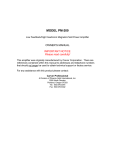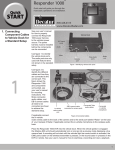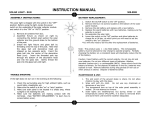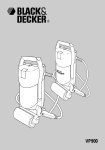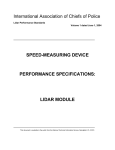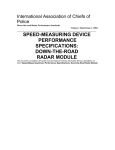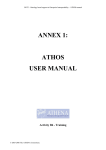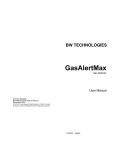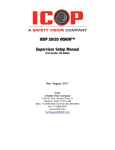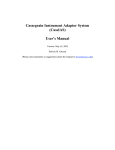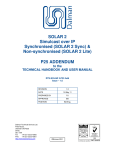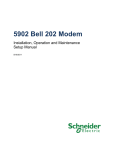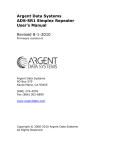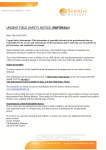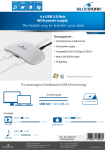Download Decatur Genesis-VP Handheld Radar
Transcript
GENESIS-VP™: User’s Manual Decatur Electronics, Inc. GENESIS-VP™ User’s Manual 715 Bright Street Decatur, IL 62522 USA/Canada: 1.800.428.4315 FAX: 1.217.428.5302 INTL: 1.217.428.4315 www.decaturradar.com Revised December 28, 1999 1 GENESIS-VP™: User’s Manual INSERT Genesis-VP Instructions for use of the target direction tracking mode. Your Genesis-VP speed radar pistol may have had target direction tracking mode added to its program software during product configuration. The following explanations and instructions apply to target direction tracking mode with the Genesis-VP. You can determine whether or not target direction tracking mode is on or off by going into the secondary menu and toggling to the “dir” window. If it says “on” then, of course, target direction tracking mode is on. If it says “off” then, of course, it is off and the unit will function as a standard Genesis-VP. When operating the Genesis-VP in target direction tracking mode: 1. The Genesis-VP will lock onto the target that has the strongest return signal and also attempt to determine that target’s direction of travel. The target’s speed will be displayed in the left window and, if successful in determining target direction, the target direction will be displayed in the right window. A “t” for “towards” will be displayed for a target moving toward the Genesis-VP and an “A” for “away” will be displayed for a target moving away from the Genesis-VP. If the Genesis-VP is not successful in determining the target’s direction of travel then neither a “t” or an “A” will be displayed. 2. When you lock a target the locked target speed will be displayed in the right window. The right display will alternately flash this locked speed and the direction of the locked target (if the direction was determined). 3. If you use the faster target mode in conjunction with the target direction tracking mode then this rule of thumb applies… When the right window is not being used by another function then a “t” for “toward” or an “A” for “away” will be displayed in the right window to indicate the target’s direction of travel. 2 GENESIS-VP™: User’s Manual Table of Contents 1. Quick Start Instructions ........................................... 4 2. Controls ..................................................................... 9 3. Displays ................................................................... 14 4. Modes of Operation ................................................ 16 5. Serial Communications Option ............................. 18 6. Field Tests ................................................................ 18 7. Care, Cleaning, and Storage .................................. 21 8. Limitations to Doppler RADAR .............................. 21 9. Warranty .................................................................. 25 10. Service Return Procedure ...................................... 26 Appendix 1, Specifications .............................................. 27 Appendix 2, FDA Notice ................................................... 28 Appendix 3, FCC/ISC Documents ................................... 30 Appendix 4, Case Law ...................................................... 31 Copyright © 1998, Decatur Electronics, Inc. 3 GENESIS-VP™: User’s Manual 1. Quick Start Instructions 1.1 Insert VersaPak™ batteries Remove VersaPak™ batteries from their package and charge them (please refer to VersaPak™ instruction sheet). When the VersaPak™ batteries are charged, insert them into the base of the handle grip as shown until you hear them snap into place. Figure 1: Inserting Batteries 1.2 Turn on the power Push the power button. The Genesis-VP™ will do a display test and beep and then blank the speed windows. 4 GENESIS-VP™: User’s Manual 1.3 Set Menu Options Primary menu You may use the factory default settings listed below or you may select your own settings. To select your own settings, press and hold the MENU button. You will see “bL” (for back light) in the left window and “OFF” in the right window. If you wish to change this to “ON,” then simply press the SEL (select) button. (The SEL button is used to toggle/cycle through all available values for a given parameter.) Release and press the MENU button again to move to the next category and repeat the process. When finished, release the buttons and your new settings will be in effect. The unit will “remember” the last settings when turned off and will power up with the last set values in each category. See section 2.3 on Menus for other settings. Factory default settings: bL (back light) .......................... = on Aud (audio volume) .................. = 3 SEN (sensitivity) ...................... = 5 SLh (squelch) ........................... = on Figure 2: Primary Menu 5 GENESIS-VP™: User’s Manual Secondary menu You may use the factory default settings listed below or you may select your own settings. To select your own settings, press and hold the SEL (select) button and then press the MENU button. You will see “Prt” (for communication port) in the left window and a “O” (for none) in the right window. If you wish to change this to an other mode of serial port communication, then simply release and press the SEL (select) button. (The SEL button is used to toggle/cycle through all available values for a given parameter.) Press the MENU button again to move to the next category and repeat the process. When finished, release the buttons and your new settings will be in effect. See section 2.3 on Menus for other settings. Factory default settings: Prt (communication port) ......... 0 = No serial communication FSt (fastest vehicle style) .......... 1 = Fastest-toggle tSt (test) .................................... off You are now ready to measure the speed of targets. Figure 3: Secondary Menu Master Reset To reset all parameters (except the “tSt” setting) to their default values, press and hold the SEL (select) button while pressing the PWR (power) button when turning the unit ON. The unit will generate a long tone, reset all parameters to the default values (see lists above), and continue powering up. 6 GENESIS-VP™: User’s Manual 1.4 Measuring the speed of a target Measuring the speed of a target in strongest signal mode. Point the Genesis-VP™ at a moving vehicle; pull and hold the trigger. While the trigger is being held, the Genesis-VP™ is transmitting a signal and measuring speeds. You should see a speed in the left window. This is the speed of the vehicle returning the strongest signal. To lock the speed, simply release the trigger and pull (and hold) it again quickly (within a half of a second) and the current speed will be locked in the right window while the left window continues to track the vehicle’s speed. To clear the locked speed, either lock another speed in the same manner or release the trigger for more than half a second and pull the trigger again. Measuring the speed of a target in fastest vehicle mode. The Genesis-VP™ can operate in one of two “fastest vehicle” modes, selected in the secondary menu, fast-hold and fast-toggle. See section 2.3 on Menus for changing to the other fastest vehicle mode. Fast-hold style. Point the Genesis-VP™ at two or more moving vehicles; pull and hold the trigger. While the trigger is being held, the Genesis-VP™ is transmitting a signal and measuring speeds. You should see the speed of the vehicle with the strongest return signal displayed in the left window. To switch to fastest vehicle mode press and hold the FAST button. You should now see the speed of the strongest of the faster vehicles in the left window. You will remain in fastest mode until you release the FAST button. To lock the speed, release the trigger and pull it again quickly (within a half of a second) and the speed in the left window will be locked in the right window while the left window continues to track the fastest vehicle’s speed. To clear the locked speed, either lock another speed in the same manner or release the trigger for more than half a second and pull the trigger again. See sections 2.3 and 4.2. 7 GENESIS-VP™: User’s Manual Fast-toggle style. Point the Genesis-VP™ at two or more moving vehicles; pull and hold the trigger. While the trigger is being held, the Genesis-VP™ is transmitting a signal and measuring speeds. You should see the speed of the vehicle with the strongest return signal displayed in the left window. To switch to fastest vehicle mode, press and release the FAST button. You should see the speed of the vehicle returning the strongest signal in the left window and the speed of the strongest of the faster vehicles in the right window. You will remain in fastest mode until you either press the FAST button again (button toggles between strongest signal mode and fastest target mode) or until you lock a speed (which automatically switches you back to strongest signal mode). To lock the speed, release the trigger and pull it again quickly (within a half of a second) and the speed in the left window (the strongest signal in this case) will be locked into the right window while the left window will continue to track the speed of the vehicle with the strongest return signal. Note that in the fast-toggle style of fastest vehicle mode you are actually locking strongest signal speeds. To clear the locked speed, either lock another speed in the same manner or release the trigger for more than half a second and pull the trigger again. See sections 2.3 and 4.3. 8 GENESIS-VP™: User’s Manual 2. Controls 2.1 Faceplate When pressing the button of a valid function on the front panel, the computer acknowledges the command with a beep. MENU The MENU button allows you to view the user programmable categories. To change the menu category, press the MENU button. SEL The SEL (select) button allows you to choose values (settings) in each of the menu categories. To change the menu category value, press the SEL (select) button. TEST When the TEST button is pressed the Genesis-VP™ will complete a self-test. See section 6.1. FAST When the FAST button is pressed the Genesis-VP™ will enter fastest target mode. PWR Turns Genesis-VP™ on and off POWER XMIT RFI HOLD MENU LOW BAT LOCK MPH KPH ERROR TEST PWR SEL FAST Figure 4: Faceplate 9 FAST GENESIS-VP™: User’s Manual 2.2 Other Controls and Features Trigger When the trigger is pulled, the Genesis-VP™ will transmit and receive information. If the trigger is released and pulled again within half a second then the speed displayed in the left window will be locked into the right window. The lock will be cleared when the trigger is released for more than half a second and pulled again. Backlighting (controlled through primary menu) Turns backlighting on and off. Audio (controlled through primary menu) Doppler tone volume control. Sensitivity (controlled through primary menu) Controls the maximum acquisition distance in five levels. Start with maximum sensitivity and decrease until attaining the desired performance. Squelch (controlled through primary menu) Determines the type of Doppler audio heard. In squelched mode (SLh = ON), the only sound heard is the Doppler tone for the displayed target. When unsquelched (SLh = OFF) , the operator hears all of the Doppler tones vehicles, interference, and noises - received by the antenna. Communications port (controlled through the secondary menu) Determines which communications port configuration is used. Fastest vehicle mode style (controlled through secondary menu) Determines whether the fastest vehicle mode will be fastest-hold or fastesttoggle. Test (controlled through secondary menu) Determines whether the unit automatically performs a “mini” self-test at regular intervals (required in some states). 10 GENESIS-VP™: User’s Manual 2.3 Menus The MENU button allows you to view the user programmable categories. There are two menus; the Primary and the Secondary. Primary Press the MENU button to enter the first category of the primary menu. To advance to the next menu category, press the MENU button again. Symbol bL Aud SEN SLh Meaning Back light Audio volume Sensitivity Squelch Range on / off 0-6 0-5 on / off Figure 5: Primary Menu 11 GENESIS-VP™: User’s Manual Secondary To enter the secondary menu, press the SEL (select) button and hold it. While holding the SEL button, press the MENU button. To advance to the next menu category value, press the MENU button again. Symbol Prt Meaning Communication port FSt Fastest vehicle tSt Mini-test Range 0 = None 1 = VISIMAX sign/video 2 = ATV sign/video 3 = Reserved 4 = Reserved 5 = Reserved 6 = Speed Tracker™ software 7 = STAR™ software 8 = Reserved 9 = Reserved 10 = Reserved 0 = Fast-hold 1 = Fast-toggle on / off Figure 6: Secondary Menu 12 GENESIS-VP™: User’s Manual NOTES: 1. The Genesis-VP™ will exit menu mode if neither the MENU or SEL buttons are pressed for two seconds. If either the MENU or SEL buttons are held, the Genesis-VP™ will stay in menu mode. 2. The primary menu functions in real time. The Genesis-VP™ will continue to transmit accurate audio and serial communications while in menu mode. A system reset will always occur when exiting the secondary menu. 3. The unit will “remember” the last settings when turned off and will power up with the last set values in each category. 13 GENESIS-VP™: User’s Manual 3. Displays 3.1 Number Segments POWER Left side: Three large digits (888) display speeds and menu categories. XMIT RFI HOLD LOW BAT ERROR LOCK FAST MPH KPH Figure 7: Number Segments and Status Indicators Right side: Three small digits (888) display speeds and “select” values. Displayed speed will be the strongest signal, or, in fastest mode, the next strongest signal that is also going faster than the strongest signal. 3.2 Status indicators (icons) POWER Indicates that power is on. RFI Indicates that there is radio frequency interference inhibiting the proper operation of the unit. No new speeds will be displayed or transmitted via the serial port while this icon is active. Locked speed will remain. Once the condition no longer exists, the unit will operate properly. Possible causes of this condition are patrol vehicle FM communications, proximity to radio stations and other broadcast equipment. LOW BAT Indicates that the batteries need to be recharged. No new speeds will be displayed or transmitted via the serial port while this icon is active. Locked speed will remain. LOCK Indicates that the speed displayed in the secondary window is a stored value that was previously displayed in the primary display window. 14 GENESIS-VP™: User’s Manual FAST Indicates that the Genesis-VP™ is in fast mode. When not in fast mode, the Genesis-VP™ is assumed to be in strongest signal mode (the default mode). The Genesis-VP™ is capable of internally tracking multiple speeds simultaneously. Each vehicle return signal is ranked by its strength and speed. XMIT Indicates that the Genesis-VP™ is transmitting. HOLD Indicates that the Genesis-VP™ is not transmitting. ERROR Indicates that the Genesis-VP™ has suffered an internal hardware error which could affect the operation of the unit. Please contact Decatur Electronics, Inc. for instructions. 1.800.428.4315. MPH The MPH icon is not used. The Genesis-VP™ is assumed to be displaying speeds in miles per hour. KPH Indicates that the Genesis-VP™ is displaying speeds in kilometers per hour. 15 GENESIS-VP™: User’s Manual 4. Modes of Operation 4.1 Strongest signal mode The Genesis-VP™ sets itself to strongest signal tracking mode when you turn it on (it will stay in this mode unless you press the “Fast” button). In strongest signal tracking mode, the Genesis-VP™ will display the speed of the vehicle with the strongest return signal in its field of view. This speed will appear in the left window. Strongest / fastest. The Genesis-VP™ internally tracks multiple speeds simultaneously. In fast (fastest target) mode the Genesis-VP™ takes the strongest vehicle return signal present and uses it as a reference point to determine a faster vehicle. The Genesis-VP™ looks at all other vehicle speeds and compares them to the reference point. It determines which vehicles are going faster than the reference point, and then, of those vehicles, which one has the strongest signal. The speed of this vehicle will be displayed. This method of fastest vehicle identification is used to add certainty to vehicle identification. There are two styles of fastest mode operation available on the Genesis-VP™. The unit can operate in only one method at a time (selected in the secondary menu). 4.2 Fastest-hold If your Genesis-VP™ uses the “fastest-hold” mode of operation and you want to see the fastest vehicle speed, then you must press and continue to hold the FAST button. When you hold the FAST button while measuring speeds, the fastest vehicle speed (if one is present) will be displayed in the left window. Removing your finger from the FAST button will cause the Genesis-VP™ to return to strongest signal mode. You will know you are in fastest target mode when the “FAST” icon is illuminated. If you lock a speed by quickly releasing and pressing (and holding) the trigger while in this style of fastest vehicle mode, the speed which is displayed in the left window (fastest vehicle in this case) will be locked and displayed in the right window. The Genesis-VP™ will remain in fastest vehicle mode as long as the FAST button is pressed. Note that the vehicle returning the strongest signal may also be the fastest vehicle. In this case this vehicle’s speed will be displayed in the left window whether you are in strongest signal mode for fastest vehicle mode. See section 2.3 on Menus for changing to the other fastest vehicle mode. 16 GENESIS-VP™: User’s Manual 4.3 Fastest-toggle If your Genesis-VP™ uses the “fastest-toggle” mode of operation, then you may toggle between fastest vehicle mode and strongest signal mode by pressing the FAST button. Each time you press the FAST button, you switch from one mode to the other. When you are measuring speeds in fastest mode using the fastest-toggle style of operation, the strongest of the faster vehicles speed will be displayed in the right window, and the speeds of the vehicle with the strongest return signal will be displayed in the left window. You will know you are in fastest vehicle mode when the “FAST” icon is illuminated. In the “fastest-toggle” mode, only the strongest vehicle speed can be locked. When the speed is locked the Genesis-VP™ will revert to strongest signal only mode. See section 2.3 on Menus for changing to the other fastest vehicle mode. If the strongest signal is also the fastest signal, no display will appear in the right window. Strongest Radar 55 Strongest of the Faster Vehicles 65 Fastest 70 50 85 Faster Vehicles Strongest Signal Fastest-hold Figure 8 Modes of Operation 17 Fastest-toggle GENESIS-VP™: User’s Manual 5. Serial Communications Option If your Genesis-VP™ has a communications connector on the side, you may connect it to Decatur’s large display signs, in-car video, or a Personal Computer which is running Decatur Electronics’ software. If connecting to a Personal Computer, plug the 9-pin end (DB-9 connector) of the computer cable into the serial communications port on your computer. Use the cable(s) that come with the sign or software (if purchased). Make sure you select the correct value under “port” on the secondary menu. 6. Field Tests There are two field tests to verify the accuracy of the GENESIS-VP™. 6.1 Self test Pressing the TEST button on the display initiates a system self-test. This test checks the left and right numeric displays and runs a simulation of the target speeds. The Genesis-VP™ will not power down while a self-test is in process. Display (LCD) test The segments in the left and right displays will be illuminated in a circular pattern to test for faulty Liquid Crystal segments. Circuitry (DSP) test The Digital Signal Processor will be tested. “PASS” or “FAIL” will appear on the display when test is completed. Speed simulation The Genesis-VP™ verifies vehicle speed acquisition using synthesized Doppler frequencies corresponding to the series of four speeds listed below. “PASS” or “FAIL” will appear on the display when test is completed. The speeds are: MPH 15, 30, 45, 60 KPH 25, 50, 75, 100 (if your Genesis-VP™ is in MPH) (if your Genesis-VP™ is in KPH) 18 GENESIS-VP™: User’s Manual 6.2 Tuning Fork Test NOTE: Keep Trigger pressed during entire test. In addition to the system test, the operator can verify the overall system accuracy by using a tuning fork. After tapping one of the tines of a tuning fork, the fork vibrates at the frequency stamped on the handle. When the operator places the tuning fork in front of the antenna, the system detects the fork and displays a speed. Compare the speed displayed to the speed stamped on the fork. The displayed speed must be within one (1) mph (or kph if testing a kph unit) of the speed stamped on the fork. Tapping the tines against surfaces like metal and concrete may damage the tines and invalidate the fork for future tests. Tap the tines against hard plastics or wood to avoid unnecessary damage. Using the fork at temperature extremes may also affect the readings. Figure 11: Tuning Fork 19 GENESIS-VP™: User’s Manual The tuning fork test consists of the following steps: • Grasp the tuning fork by the handle and tap one of the tines against a firm surface. • Hold the vibrating tuning fork approximately three (3) inches from the front of the antenna. • Verify that the displayed speed and speed marked on the tuning fork are within one (l) mph of each other. If there is a large difference between the displayed speed and the fork, check the tuning fork for damage. Repeat the procedure with another, certified tuning fork. If the error is still greater than one (l) mph, remove the unit from service. • Verify that the Doppler audio is correct for the speed displayed and not corrupted by noise. (Tone can be compared to the tones generated during a test initiated with the TEST button.) • The display should blank when the fork is not in front of the antenna or the vibrations have ceased. Figure 12: Tuning Fork Placement 20 GENESIS-VP™: User’s Manual 7. Care, Cleaning, and Storage Do not spill food, beverages or other liquids and substances on the GenesisVP™. When the Genesis-VP™ is not in use or when it is being transported, store it in its original packaging. To clean the Genesis-VP™, dust it lightly with a soft clean cloth. The cloth should be free from any cleaning solutions. 8. Limitations to Doppler RADAR When properly used, the Doppler radar system is extremely accurate and reliable. However, the variations in the environment can cause situations and circumstances which may create speeds that appear incorrect. 8.1 Cosine Effect The cosine effect causes the system to display a speed that is lower than actual vehicle speed. This condition exists whenever the target vehicle’s path is not parallel to the antenna, including curves and hills. In all uses of police radar, there is always a slight angle between the patrol and target vehicle to avoid collisions. Whenever the angle between the beam of the antenna and the target vehicle increases, the displayed speed decreases. Ideally, an angle of zero (0) degrees is preferable, since the displayed speed will be the actual target vehicle speed. The following table shows the effects that an increasing angle can have on the speed displayed. At angles less than 10°, there is not much difference between the target and actual speed. As the angle increases, the error increases. At 90°, the TARGET speed is zero mph - grossly incorrect. 21 GENESIS-VP™: User’s Manual Figure 13: Possible Cosine Effect on Curve Actual Speed Angle, in degrees 0 1 3 5 10 15 20 30 45 60 90 30 mph 30 29 29 29 29 28 28 26 21 15 0 40 mph 40 39 39 39 39 38 37 34 28 20 0 50 mph 50 49 49 49 49 48 46 43 35 25 0 60 mph 60 59 59 59 59 57 56 51 31 30 0 70 mph 70 69 69 69 68 67 65 60 49 35 0 80 mph 80 79 79 79 78 77 75 69 57 40 0 Table 1: Actual and Displayed Speeds at Different Antenna-to-Target Angles 22 GENESIS-VP™: User’s Manual 8.2 Interference Radar systems, like any other radio system, are subject to external interference. The two most common kinds are radio frequency interference and undesired moving objects. Radio Frequency The system may inadvertently process radio frequency energy from airport radar, streetlights, high-tension power lines, microwave transmission towers, CB radio transmitters, and AM/FM transmission towers as Doppler speeds. The Genesis-VP™ unit has a radio frequency interference (RFI) detection circuit, designed to detect excess radio frequency energy. When stray radio frequency energy reaches an excessive level, the system will illuminate the “RFI” icon in the display. Once the source of radio interference ends, the system will resume normal operation. Also, any locked speeds will return to the lock window. Moving Objects The system may also detect other moving objects in the antenna’s beam. Fan blades, in the patrol vehicle, can generate undesired Doppler signals. Since these signals can be similar to moving cars, the operator needs to discern between a valid target and a source of interference. Usually, a source of moving interference exhibits the following characteristics: • A reading when there is not a target vehicle in the operational range of the antenna. • A target vehicle, upon entering the operational range, will override the interference signal-causing the displayed speed to change suddenly. • The Doppler audio will be corrupted with noise, unlike a good, clear Doppler tone. • Interference is irregular and does not provide a valid tracking history. 23 GENESIS-VP™: User’s Manual 8.3 Multi-path Beam Cancellation When multi-path beam cancellation occurs, the target vehicle speed display will sporadically blank and reappear. This occurs when the radar looses track of a target vehicle at semi-random intervals. The target vehicle is reflecting two signals that are interfering with one another. When the phase of the two signals is 180°, maximum interference occurs and the signals cancel, causing the system to ignore the target vehicle. When there is only one target vehicle, the system will reacquire the speed of the vehicle. However, when more target vehicles are present, the system could lock onto another vehicle. The operator can minimize the confusion of multi-path beam cancellation with an accurate tracking history of the original target vehicle. 8.4 Scanning All radar antennas, for police applications, are designed to be operated from a fixed mounting, or to be hand-held in a steady position. Moving or “scanning” the antenna past stationary objects can cause the system to detect the motion. A speed-reading obtained from scanning requires deliberate misuse. 24 GENESIS-VP™: User’s Manual 9. Warranty T WO YEAR RADAR WARRANTY Decatur Electronics, Inc. guarantees the Genesis-VP™ to be free from defects in workmanship and material, and to operate within specifications for a period of two years. During this period, Decatur Electronics, Inc. will repair or replace, at its option, any component, except batteries or chargers, found to be defective, without cost to the owner, provided the unit is returned to the factory. The full warranty on parts and workmanship does not include normal wear and tear, crushing, dropping, fire, impact, immersion, or damage from attempted repair or modifications by unauthorized service agents. Simply return the unit (transportation prepaid) directly to the factory or to an Authorized Decatur Electronics Warranty Service Center near you. If you have any questions, or want a quick problem diagnosis, please call our customer service hot-line and ask for the service department: phone: 1.800.428.4315 fax: 1.217.428.5302 TWO YEAR WARRANTY EXCEPTION If the unit was purchased under a special buying program (state purchase contract, etc.), then the above warranty may not apply. Please refer to the buying program contract for the appropriate warranty terms, or contact Decatur Electronics, Inc. at the above phone number. EXTENDED WARRANTY OPTIONS If you are interested in an extended warranty, contact your sales representative to discuss extended warranty options. 25 GENESIS-VP™: User’s Manual 10. Service Return Procedure If it becomes necessary to return the Genesis-VP™ to the factory, please follow the procedure below: • Return ALL pieces of the Genesis-VP™ in the original packaging • Include a note describing the malfunction of the system, or the incident that resulted in a malfunction. Failure to do so may delay the return of the system. • Telephone the Customer Service Department, at Decatur Electronics: 1800-428-4315, to obtain a return authorization (RA) number. Write the RA number on the note and shipping label. • Return the system to: Decatur Electronics, Inc. 715 Bright Street Decatur, IL 62522 USA RA#: xxxxxx The shipping charges, for sending the system to Decatur Electronics, Inc., are the responsibility of the customer. If a system, still under warranty, is received COD from a customer, the customer will be charged for the amount of the COD freight charges plus an additional 10% for handling, after the system is repaired. The COD and 10% handling fee will be added to the repair bill as out-of-warranty repairs. Decatur Electronics, Inc. will pay the freight (up to $10.00 US) for shipment of the system from the repair facility to the customer, provided that the system is still under warranty. Any shipping charges, above the initial $10.00, will be charged to the customer. If Express or Next Day Air is desired, the customer will be invoiced for the freight charges, even if the system is still under warranty. An estimate can be furnished for repairs that are out-of-warranty, at the customer’s request, for $50.00 US. Even if the customer decides to not have the repairs completed, they will be invoiced for the $50.00, plus return freight. If Decatur Electronics proceeds with the repairs, there will be no charge for the estimate. 26 GENESIS-VP™: User’s Manual Appendix 1, Specifications Antenna Parameters K-Band IACP Type Nominal Transmission Frequency Nominal Horizontal Beamwidth Polarization Nominal Microwave Power Output Maximum Aperture Power Density III 24.150 ±50 MHz 12° Circular 10 mW ≤1 mW/cm2 Environment Ambient Operating Temperatures Maximum Humidity Water Resistance -30°C to +70°C -22°F to +158°F 90% relative humidity at 37°C (non-condensing) Meets International Robustness Standard IEC 529:1989 and European Community Standard EN 60529 Classification IP55. These set international standards for immunity from damage by solid protrusions and water. Voltages Supply Voltage Low Voltage Threshold 5.5 VDC — 8 VDC Power supplied from replacable Ni-Cad batteries 5.5 VDC Speed Range Parameters Speed Display Ranges Target: mph Option kph Option Minimum 5 8 27 Maximum 200 320 GENESIS-VP™: User’s Manual Appendix 2, FDA Notice 28 GENESIS-VP™: User’s Manual 29 GENESIS-VP™: User’s Manual Appendix 3, FCC/ISC Documents This page reserved for Grant of Equipment Authorization. Note: This equipment has been tested and found to comply with the limits of a Class B digital device, pursuant to part 15 of the FCC rules. These limits are designed to provide reasonable protection against harmful interference in residential installation. This equipment generates, uses and can radiate radio frequency energy and, if not installed and used in accordance with the instructions, may cause harmful interference to radio communications. However, there is no guarantee that interference will not occur in a particular installation. If this equipment does cause harmful interference to radio or television reception which can be determined by turning the equipment off and on, the user is encouraged to try to correct the interference by one or more of the following measures: • Reorient or relocate the receiving antenna • Increase the separation between the equipment and receiver • Connect the equipment into an outlet on a circuit that is different from that which the receiver is connected • Consult the dealer or an experienced radio/TV technician for help. 30 GENESIS-VP™: User’s Manual Appendix 4, Case Law Judicial notice is an elementary principal of law. The principal applies to facts that are common knowledge and states that it is necessary to introduce evidence to prove what is common knowledge. The following landmark rulings have made it simpler to introduce RADAR SPEED MEASUREMENTS as evidence. 1. State v. Dantonio in June 1995, State of New Jersey. The New Jersey Supreme Court took judicial notice of the Doppler Principle. Other States quickly followed. 2. State v. Tomanelli in 1966. The court pointed out that while the tuning fork method is acceptable, the result of the test is only as good as the tuning fork used. 3. Honeycutt v. Commonwealth in 1966. The court ruled that it is sufficient for an officer to have enough knowledge and training to properly: • Setup RADAR. • Test its accuracy. • Read the instrument to obtain the speed measurement. 4. State v. Hanson in 1978. The court decreed that the officer must be able to testify: • To having had adequate training and experience in the operation of the moving RADAR. • That the moving RADAR instrument was in proper working order and that its testing had followed suggested methods. • That the instrument was used in an area where road conditions presented only the minimum possibility of distortion. • That the patrol car’s speed was verified. • That the instrument was expertly tested soon after the arrest and that the testing did not rely on the instruments own internal circuit testing. 31 GENESIS-VP™: User’s Manual Notes 32 GENESIS-VP™: User’s Manual 33 GENESIS-VP™: User’s Manual 34


































